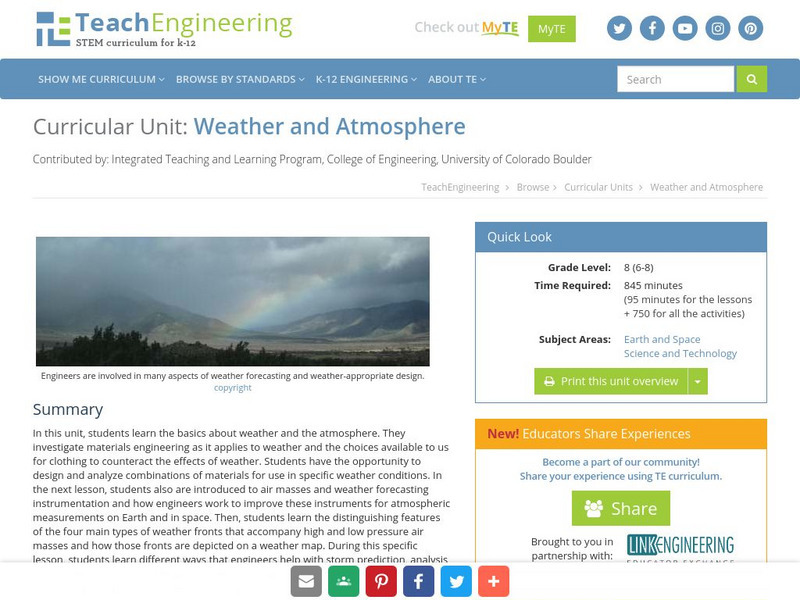Curated OER
Rain Making - Understanding the Formation of Rain
Learners read and conduct and experiment to learn about rain formation. In this water forms lesson, students read about the formation of rain and its purposes. Learners then complete a rain experiment activity.
Curated OER
DEW POINT
Fourth graders investigate conditions causing saturation and measure the dew point of the atmosphere performing simple experiments.
Curated OER
How Much Is an Ecosystem Worth?
Students examine the value of ecosystems. They read and analyze an article, evaluate ecosystem services, research the benefits of biomonitors, and design a public service announcement.
Curated OER
Water Cycle in a Box
Fourth graders investigate how the water cycle is vital for all living things to survive on Earth. They observe the teacher set up a simulation of the water cycle using a Plastic Earth Simulator, desk lamp, and water, and make...
Curated OER
Hurricanes Are They Coming to Your Neighborhood?
Students study weather systems, hurricanes and tropical storms. They predict landfall of hurricanes and tropical storms.
Curated OER
You Can Be A Woman Meteorologist
Students complete four activities that are about meteorology. The first activity is for them to explore weather maps. The second activity is for students to discover high-pressure and low-pressure air. The third activity is for them to...
Curated OER
Name that Wind
Students study wind and the direction terms related to wind. In this meteorology lesson, students learn about the wind directions by completing a wind direction activity where kids locate cones marked with the specific wind...
Curated OER
Cloud Types
Students examine cloud types. In this cloud lesson, students identify cloud types, observe clouds and collect data, and analyze data to identify the most common cloud they observe overhead during the course of a month.
Curated OER
Atlantic Canada Report
Ninth graders create a report that will show an in-depth knowledge of the various geographical and climatic features of Atlantic Canada. They produce various items, on paper and using the computer, to demonstrate knowledge of outcomes,...
Curated OER
Mapping a Temperature Field
Students measure and graph temperatures. In this temperature field lesson plan students use a map to measure and plot field values and construct isolines and interpret the results.
Curated OER
Wacky Water Critters
Students visit a local creek or stream. They collect water samples from the creek and observe and sort the "water critters" they find in the sample, observing smaller organisms under a microscope if necessary. They identify each organism...
Curated OER
Watching the Clock: An activity to build media-savvy students
Students analyze time constraints on broadcast news. They apply data collecting and data display skills. They identify the difference between news progams and the evening news.
Curated OER
The Beaufort Scale: A Local Model
Students study the Beaufort Scale and use it to study wind in their community. In this wind study lesson, students watch a DVD about climate change and learn about the Beaufort Scale. Students complete a worksheet for the topic.
Curated OER
Thunderstorms
Fourth graders investigate the attraction between two different charges to explain the concept of lightning in a thunderstorm.
Curated OER
Planning a Tourist Resort
Students work in teams of 2 to complete the presentation portion of the assignment. They may be required to work alone or may work with their partner to complete the "Board Member's Responses."
Curated OER
Thar She Blows!
Young scholars identify the advantages and disadvantages of wind farms and turbines. They examine how weather conditions can affect their effectiveness and how engineers are trying to solve the problem. They discover how engineers use...
Curated OER
Understanding Cloud Formation
Students explore air and clouds by watching demonstration. They perform an experiment to measure air pressure changes.
Alabama Learning Exchange
Researching Hurricanes with Technology
Young scholars explain the components that make up a hurricane.
Curated OER
Making Lightening: In Your Mouth
Students look at a lightening demonstration. For this lightening lesson, students bite into a wintergreen candy while looking in the mirror in a dark room. They see sparks in their mouths if they perform the task correctly.
TeachEngineering
Teach Engineering: Weather and Atmosphere
In this unit, students learn the basics about weather and the atmosphere. They investigate materials engineering as it applies to weather and the choices available to us for clothing to counteract the effects of weather. Students have...
University of Illinois
University of Illinois Urbana Champaign: Air Masses and Fronts
What are air masses and where do they originate? What happens to the weather along fronts? Learn about warm and cold fronts and different types of advection. Maps and animated illustrations make these topics easier to comprehend.
American Geosciences Institute
American Geosciences Institute: Cold Front and Warm Front
Read and understand the differences between a cold and a warm front.
Scholastic
Scholastic: Study Jams! Science: Weather & Climate: Air Masses & Fronts
A video and a short multiple-choice quiz on the topic of air masses and fronts. It describes the types of weather fronts, what an air mass is, and the four types of air masses in the US.
USA Today
Usa Today Weather: Understanding Storms and Fronts
Discusses air pressure, fronts, and storm formation. Links on page to well-illustrated and animated additional information.























